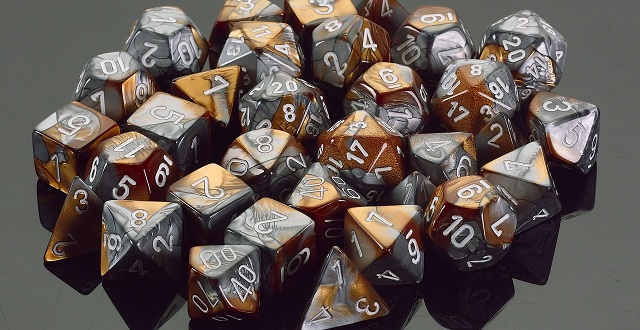Dread – Pen & Paper RPGs Part II
 If you’re a veteran of pen and paper games who wants to try something exciting, a new player who wants to dabble in the shallow end of the pool before diving into more complicated systems or a player who is returning to the table after a long absence, Dread is the perfect game for you. Dread is a horror game with unique mechanics and character creation that will lead to tense and brutal gaming sessions. It is one of the few titles that can only be played in person, and when done well it will leave you with an experience you’ll be talking about for years. Interested? Read on to find out how the dizzying depths of Dread will shake you up more than any game of Dungeons and Dragons.
If you’re a veteran of pen and paper games who wants to try something exciting, a new player who wants to dabble in the shallow end of the pool before diving into more complicated systems or a player who is returning to the table after a long absence, Dread is the perfect game for you. Dread is a horror game with unique mechanics and character creation that will lead to tense and brutal gaming sessions. It is one of the few titles that can only be played in person, and when done well it will leave you with an experience you’ll be talking about for years. Interested? Read on to find out how the dizzying depths of Dread will shake you up more than any game of Dungeons and Dragons.
Unlike other games where the character creation sheet looks like a tax form, Dread uses a truly unique system. The game master (GM) will prepare a series of ‘archetypes’ for the players to choose from. For instance, in a sci-fi game that was inspired by the video game Dead Space, the available roles were: the navigator, the mechanic, the pilot, the medic, the captain, the corporate sponsor, the soldier, and the alien. In a modern day monster hunter game, the options were: the veteran, the nun/priest, the new guy, the paramedic, the cop, the nerd, and the thug. Archetypes should form a picture in the players mind nearly immediately, and provide a solid foundation for a player to role play off of. (A helpful hint: prepare more characters than there are players. Dread is notoriously fatal, and a player should be able to get back into the game with a new character upon death.)
Instead of mapping out stats, perks, equipment or skills, Dread asks you to build a character. Upon choosing an archetype, the GM will hand you a character sheet. Character sheets can be found in pre-made adventures online, or you can write your own to customize your session. Players should, under no circumstances, share character sheets with each other. The contents are a mystery to everyone but the respective player and the GM. Character sheets have questions like: “What is your name?” or “How long have you been working in your role?” and “Why are you part of this expedition?”. These questions allow the player to make a more specific picture of the character they are playing. Then, questions become more specific. While playing the navigator in the previously mentioned sci-fi campaign, the sheet asked me: “You are one of the most skilled navigators in the fleet. Why are you on this small ship in the middle of nowhere?” I concocted an explanation where my navigator had an anger problem and was demoted to teach her a lesson after punching someone in the face. The anger problem carried over into how I interacted with the other players; I played a brusque, cranky and slightly dangerous team mate. My fiancé played the mechanic, and one of his questions was: “The long hours and high stress of your job mean you have taken up a bad habit. What is it?” The result of this question was an addiction to stims that troubled his character throughout the game.
Once everyone has filled out their character sheets, the game begins. The GM guides players through the scenario. Instead of rolling dice, combat and skill checks are resolved in a much more tense way: a tower of Jenga. (If you and your friends are skilled at Jenga to such an extent that the game becomes trivial, pick up Extreme Jenga to restore the tension and fear to skillchecks.) Upon having to hack a computer, shoot a gun, wrestle a foe or escape through a window, the player must successfully pass a round of Jenga. At first, this is easy, but as the session continues the tower becomes increasingly wobbly and skill checks become more and more tense. Characters are often capable enough to, say, pick a lock without having to pull a block, but that changes when the zombie horde is roaring right behind you and the door is the only way out.
So what happens if the tower falls? The player fails their check and the entire tower topples. The result is total failure: their character dies, or goes insane, or succumbs to dark forces. Subsequently, the character is removed from the game and the player must choose a new one. The tower is rebuilt after failure, meaning that the checks become easier once again. This not only makes gameplay exceedingly tense and scary, but it also gives players choices. For instance, if a tower is precariously high and the player is not looking out for number one, he or she can intentionally smash the tower down for a heroic sacrifice. Every skill check becomes a challenge beyond just rolling a dice and waiting for results, and so gameplay is incredibly fraught with fear and worry.
Dread is great for one-shots as opposed to long campaigns, so it’s a wonderful game to try on a lark. It also teaches players and Game Masters useful habits: how to roleplay, how to set up a tense scene, how to think of their characters as three dimensional people and not avatars, and how to keep secrets from other players. Being the Game Master for Dread can be challenging due to having to create tension, but it is incredibly rewarding to pull that aura off. Out of my years of pen and paper games, the games I remember most are always Dread sessions. I highly recommend Dread to all sorts of players – just as long as you can keep yourself from peeing your pants.
About This Post
